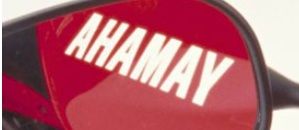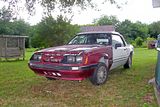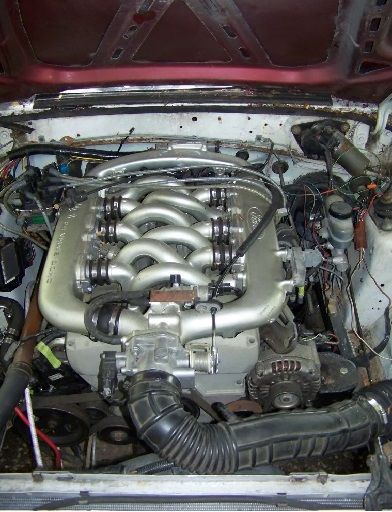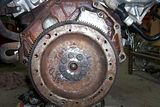Can anyone say ahamaY?

Of all the designs that spawned the Duratec 4's and V6's, the specifically Yamaha designed SHO Taurus designed V6 is the most compact and smartest quad cam engine ever. Its the heir to the Aston Martin V12, the SHO V8, the Volvo S80 V8, and the legion of Yamaha v6 and v8 jet boat engines.
Fox parts raiders can take a leaf from mgman75's book, grab an old lowly Fox like a 1993 2.3 Mustang and plumb in the SHO, an Areostar 4-speed auto, and turn it into this

into this

Ditch the EFI, and run six or eight motorbike carbs, depending on if its an SHO6 or 8. The frame is basically Aussie Ford Cortina, and they've been using rat rod chassis horn mounted frames since 1977 for there TE and TF's, and those kind of engine mounts are dead easy to fit up.
http://s177.photobucket.com/user/mgm...11014.jpg.html
Its a more expensive Fox body engine, but a great, cheap pickup good if it it hasn't been broken by they low rent hollow camshaft in the SHO8 engine from the Taurus.
V6 and V8 SHO engines into a Fox work well, and use the small HSC Tempo/Taurus/CVH/ EAO bellhousing, which means the Explorer and Ranger 4 and 5 speed automatic bolts right up to the Front drive bellhousing with virtually no mods.

 http://ultimatefoxbody.com/forum/vie...hp?f=233&t=622
http://s177.photobucket.com/user/mgm...cture.mp4.html
http://ultimatefoxbody.com/forum/vie...hp?f=233&t=622
http://s177.photobucket.com/user/mgm...cture.mp4.html
How Ford got such an amazing engine is a real good story. To keep costs down by contracting out the insane development costs of twin and quad cam engines, Ford played off the 3.78" bore spacing 1970 British twin cam BDA Cosworth and 4.32" bore spacing 1974 quad cam GAA Cosworth engines with the 4.0157" bore spacing Japanese Yamaha development team in the mid 80's. The factory Ford Cosworth GAA predated the SHO 6 14 year in the 400 hp RS 3400 Ford Capri race engines. It was also used in British Formula F5000 races where it ate up small block 302 fuel injected Chevs for breakfast.

At that stage, Cosworth and Ford was working hard to make better power for Formula 1 DFV 183 cube race engines. The costs were huge, so consulting businesses were keen to win four and five valve per cylinder head and engine supply contracts. The Japanse and Yamaha even made a sensational 5 valve per cylinder head to fit to the Coworth DF series engine, and it was supplied to Cosworth for testing. It did well over 500 hp with ease but was irratic through the rev range. The point was, with the the 400 hp plus championship winning Cosworth V6's based on the Essex 60 degree V6 with 4.32 bore spacing engine used in the English Capri already a reality, all Ford Dearborn had to do was farm out the 1988 SHO engine to the Japanese Yamaha. The result? The full supply of 3.0 and 3.2 SHO V6's and then 3.5 liter SHO8 V8's. Only the quad cam best six cylinder engine ever made. That the later SHO 8 engine that replaced it became a major service disaster was due to the hollow cam shaft process, but the rest of the concept was very sound. What is really funny is that the Vulcan was a clean sheet metric design, not related to the Cologne V6's 1936 two stroke Graf und Stiff tooling sizes, but was loosely 1966 British Essex 60 degree V4 and V6 based, with the same deck and bore spacings, but metricated with a Ford Cologne Pinto bellhousing. The Vulcan heads are basically huge classic D port 3.0 Essex Capri. When quad cams were placed on it, the engine was way too big to easily fit in a front drive Taurus or Tempo, so Ford got a totally new smaller bore spacing engine from Yamaha. That's how samrt Ford Dearborn were, there were already Cologne 4.78, Essex 60 and Vulcan 4.32, and Essex 90 4.2125" bore spacing V-sixes, and then, sudddenly, the 4.0157" bore spacing Yamaha SHO 60 degree which then forms the base for every other Duratec V6.
In my opinion, the pick of the litter for Foxes is the Yamaha based 60 degree. You can see its potential today as the bored and stroked out Yamaha F350 outboard 5.3 liter 60 degree V8. When used in the Taurus, Ford SVO made a kit in the 90's for this in RWD platforms, but it cost someting like 12 grand large back in the day. Since the second-generation S80 engine is the Yamaha V8 engine these days, all the SHO 8, Volvo 60 degree V8 Yamaha outboard engines are effectively based on the 4.0157" bore spacing 1988 Taurus SHO engine. Ford owns the rights to there's, but since Ford farmed out its developement to Yamaha, the Japanese plant still makes 6 and 8 cylinder engines with the same hard dimensions for power boat outboards as the SHO engine. It's
the most sensational over head cam engine family ever made, as it combines tight bore spacings with a conventional 60 degreeused its plant to build. And it has been made in V6, V8, V12 form. Ford may have had issues with making the Fords Premum Automotive division make money, but Volvo, Aston Martin, Mazda and Jaguar used this engine configuation with stella success. It was built in other plants asside from Cleveland. In Variable Valve Timing form, its a docile engine with a top end to die for.
This 4.0157 (102mm) bore centre Ford Duratec/ Mazda AJ V6 was doubled up to form the Aston Martin V12, and in other forms, the Front Drive Volvo 60 degree V8 and SHO 6 and 8 cylinder engines are the Yamaha 6 and v8 outboard engines, and are the worlds most compact engine for capacity. The bore spacing is the key to its origin. The Vulcan engine in the Taurus/Sable was ex Ford of Europe 60 degree V4 and v6 Essex and had a huge 4.32" bore spacing, not the same. With the SHO, Ford farmed out development to Yamaha. It's not the same as the joint effort between Mazda K and Suzuki H series used in Suzuki Vitaras, and Probe platform drive Mazdas. And not the same as the illfated J series V6. The Cologne 4.76" spacing 60 degree V4 and V6 engine is not related.
Effectively, the Aston Martin V12 engines were two SHO V6's joined together. When they came out, the Duratech 25 and 30 [2,967 cc (181 cu in)] was found in Ford Taurus/Mercury Sable, Jaguar S-Type, Lincoln LS, Mazda MPV, Mazda 6, Mondeo ST220 and many other Ford vehicles. It is essentially an 89mm bore version of the 1994 Duratec 25 and is built in Ford Motor Company's Cleveland Engine #2 plant in Cleveland, Ohio. The Duratec 25 was a 2544 cc (155 cu in) 60° V6 and was introduced in 1994. It was developed for the Ford Contour and used in the Ford Mondeo, Mercury Cougar, Mercury Mystique, Jaguar X-Type. The key to the orgins of this engine was the smaller bore spacing. For instance, Ford and Mazda have global engines with many differernt bore spacings, but tsome are actually reworks of other basic Ford engines, like the Ford sixes 4.08" distance that has reapered in Mazda MZRs 2.3 Four cylinder OHC engines.
The whole family of 60 degree Ford Yamaha Mazda Volvo 4.0157" spacing engines was different to the Mazda narrow bore spacing 985 cc PC, 1272 cc TC, 1416 cc UC, 1586 cc NA, 1796cc VB and 1970cc MC based 3.346" bore spacing xC design which the E and early B family was an evolution of , and then the bigger bore spacing medium spacing F series Mazda FWD Capella/626/Probe 1983 to date gasoline and diesel engines. The MZR is 3.76" Ford Kent/ BDA/BDT DOHC. Some of the early Ford Duretec engines are 3.614" bore spacing engines.













 Reply With Quote
Reply With Quote

Connect With Us